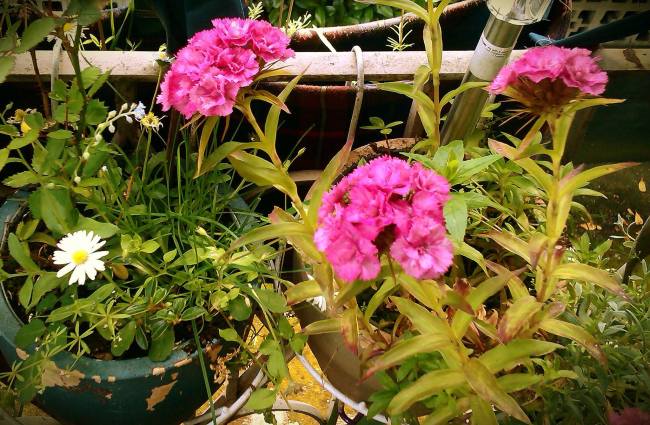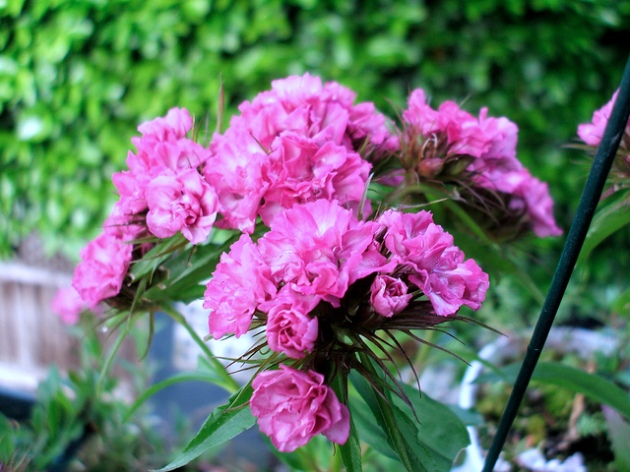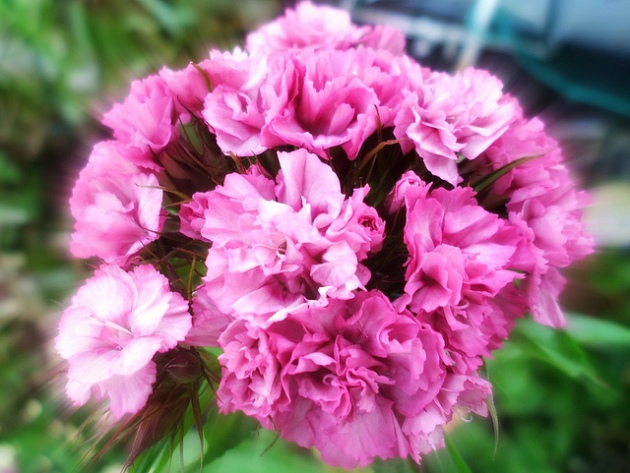Dianthus Plant
-
Dianthus is a genus of about 300 species of flowering plants in the family Caryophyllaceae, native mainly to Europe and Asia, with a few species extending south to north Africa, and one species in arctic North America. Wikipedia
-
Scientific name: Dianthus
-
Rank: Genus
-
There are numerous types of dianthus, so there’s one for almost any garden situation. Many types have flowers with a fragrant, spicy scent and notched petals. Common dianthus include Sweet William, pinks, and carnations.
About This Plant
Most dianthus have pink, red, or white flowers with notched petals. Sweet Williams are biennial or short-lived perennials covered with bicolor flowers in late spring. Pinks are low-growing dianthus suitable for rock gardens. Carnations are taller and good for bouquets but tend to be less hardy than other dianthus.
Special Features
- Multiplies readily
- Fragrant
- Good for cut flowers -Carnations for cut flowers
- Deer resistant
Site Selection
- Select a site with full sun and well-drained soil, preferably with neutral to alkaline soil pH. Dianthus won’t tolerate wet soils, especially in winter.
Planting Instructions
- Plant in spring or fall, spacing plants 6 to 12 inches apart, depending on the type. Prepare the garden bed by using a garden fork or tiller to loosen soil to a depth of 12 to 15 inches, then mix in a 2- to 4-inch layer of compost. Dig a hole twice the diameter of the plant’s container. Carefully remove the plant from its pot and place it in the hole so the top of the root ball is level with the soil surface. Carefully fill in around the root ball and firm the soil gently. Water thoroughly.
Care
- Apply a thin layer of compost each spring, followed by a 2-inch layer of mulch to retain moisture and control weeds. Water plants during the summer if rainfall is less than 1 inch per week. Stake tall varieties to keep them upright. Remove spent blooms on tall varieties, or shear back mounding plants after bloom to encourage rebloom. After the first killing frost, cut stems back to an inch or two above soil line. Divide plants every 3 to 4 years as new growth begins in the spring, lifting plants and dividing them into clumps.
Dianthus barbatus (Sweet William- above) is a species of Dianthus native to southern Europe and parts of Asia which has become a popular ornamental garden plant. It is a herbaceous biennial or short-lived perennial plant growing to 30–75 cm tall, with flowers in a dense cluster of up to 30 at the top of the stems. Each flower is 2–3 cm diameter with five petals displaying serrated edges. Wild plants produce red flowers with a white base, but colours in cultivars range from white, pink, red, and purple or with variegated patterns. The exact origin of its English common name is unknown, but first appears in 1596 in botanist John Gerard‘s garden catalog.
The flowers are edible and may have medicinal properties. Sweet William attracts bees, birds, and butterflies.
Description
Sweet william is a herb biennial or short-lived perennial plant native to the mountains of southern Europe from the Pyrenees east to the Carpathians and the Balkans, with a variety disjunct in northeastern China, Korea, and southeasternmost Russia.It grows to 30–75 cm tall, with green to glaucous blue-green tapered leaves 4–10 cm long and 1–2 cm broad. The flowers are produced in a dense cluster of up to 30 at the top of the stems and have a spicy, clove-like scent; each flower is 2–3 cm diameter with five petals with serrated edges; in wild plants the petals are red with a white base.
There are two varieties:
- Dianthus barbatus var. barbatus. Southern Europe. Leaves broader, up to 2 cm broad.
- Dianthus barbatus var. asiaticus Nakai. Northeastern Asia. Leaves slenderer, not over 1 cm broad.
English name
Many legends purport to explain how sweet William acquired its English common name, but none is verified. “Sweet William” is often said to honour the 18th century Prince William, Duke of Cumberland. As a result of the Duke’s victory at the Battle of Culloden and his generally brutal treatment of the king’s enemies, it is also claimed that the Scots sometimes call the flower “Stinking Billy”.] Though this makes a nice story, it is entirely untrue. The Scots sometimes refer to the noxious ragwort, not Dianthus barbatus, as “Stinking Billy” in memory of the infamous Duke. Also, the English botanist John Gerard referred to Dianthus barbatus as “Sweete Williams” in his garden catalogue of 1596, 150 years before Culloden. Phillips speculated that the flower was named after Gerard’s contemporary, William Shakespeare. It is also said to be named after Saint William of York or after William the Conqueror. Another etymological derivation is that william is a corruption of the French oillet, meaning “little eye”. Sweet william is a favourite name for lovelorn young men in English folkloric ballads, e.g., “Fair Margaret and Sweet William.”
 Cultivation and uses
Cultivation and uses
- Sweet william is a popular ornamental plant in gardens, with numerous cultivars and hybrids selected for differing flower colour, ranging from white, pink, red, and purple or with variegated patterns.
- The plant was introduced to northern Europe in the 16th century, and later to North America and elsewhere, and has become locally to widely naturalised in these areas.
- John Gerard praises its beauty but omits any reference to medicinal uses. Its height makes it convenient for flower arrangements. In the Victorian language of flowers, sweet william symbolizes gallantry. The plant is widely used in borders, rock gardens and informal country cottage style gardens. Sweet william is a good candidate for a naturalistic garden because its nectar attracts birds, bees, and butterflies. Its flowers are considered edible.
- It thrives in loamy, slightly alkaline soil with sun to partial shade. Propagation is by seed, cuttings, or division, but seeds of cultivars will not breed true. If it is planted from seed after the last frost, it will flower in the second year. If it is planted in flats before the last frost and then transplanted it may flower in the first year. Some gardeners recommend deadheading to encourage further flowering. The plant is self-seeding. Sweet william can suffer from Fusarium Wilt which causes the leaves to curl or droop down.
- In 1977 the question of possible medical uses was revisited by Cordell. Saponins were found in sweet william, but there has been little followup.
- At the wedding of Prince William and Catherine Middleton on 29 April 2011, Catherine Middleton included sweet william in her bouquet, a tribute to her bridegroom.

Chinese Pinks, also popularly known as Indian Pinks or Japanese Pinks are a free blooming variety of plants originated in Eastern Asia. The scientific name of these plants is Dianthus chinensis or Dianthus sinensis. The pinks are excellent for beds, borders, edgings, rock gardens, pots and cut flowers.
- The Dianthus chinensis varieties are specially suitable for borders, Dianthus heddewigii for bedding and edging, Dianthus lacinatus for rockery and bedding and the hardy perennial pinks – Dianthus plumerius, Dianthus allwoodi, Dianthus winteri, etc.) for rock gardens and edging.
Chinese Pinks bear brilliantly colored large delightfully fragrant flowers. The Chinese Pink flowers may be self-coloredexquisitely marked, edged, blotched, spotted, or eyed with contrasting colors. In some, the flowers have finely fringed petals. There are also varieties producing blooms in clusters on upright and strong stems. The name pinks doesn’t imply only pink colored flowers. They come in a wide variety of colors viz., pink, rose, scarlet, red, crimson, and so forth.
The pinks are propagated by seeds. They flourish well in sunny to part shady, moderately dry, well-drained, organic-rich soil. A very ornamental plant, it is usually biennial in habit, but can be a short-lived perennial.
The Chinese pinks have high medicinal value. They have been used for over 2,000 years in Chinese herbal medicine. The whole plant is a bitter tonic herb that stimulates the digestive and urinary systems and also the bowels. It is also anthelmintic, antibacterial, antiphlogistic, diaphoretic, diuretic, emmenagogue, febrifuge and haemostatic. It is used internally in the treatment of acute urinary tract infections (especially cystitis), urinary stones, constipation, failure to menstruate and many other physiological aberrations and dysfunctions.


![20170123050651-f09370cbed.[gif-2-mp4.com] 20170123050651-f09370cbed.[gif-2-mp4.com]](https://live.staticflickr.com/428/32472212275_9af8805d25_m.jpg)


